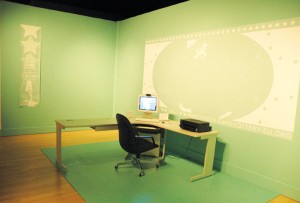« Reviews
Where Do We Migrate To?
Center for Art and Visual Culture. University of Maryland - Baltimore
Curated by Niels van Tomme
By J.W. Mahoney
Visual artists have, for many centuries, been readily useful as the only capable recorders of the visual character of their times - in cultural, natural, or social contexts. The artist Jacques Le Moyne made the only extant visual records of the indigenous Timuqua culture in northern Florida in the mid-1560s, just as photographer Edward Burtynsky documented the shipbreaking and shipbreakers on the coast of Bangladesh in 2001. What moved both these projects past their vitally reportorial status into an aesthetic one was an indefinable quality of grace merged with a powerfully undeniable realism.

Société Réaliste, E.U. Green Card Lottery, 2005-ongoing, materials and dimensions variable. Courtesy of the artists.
Much of the work in this exhibition - of 19 artists or artist collectives - curated by Washington’s Provisions Learning Project curator, Niels van Tomme, possesses both. The specific focus of the show is how the issue of global migrations of individuals from one culture to another, for political asylum, economic survival, or deep personal intent, resonates toward, impacts on, or vitalizes aesthetic expressions. Sometimes a quiet - or shrill - self-righteousness on the part of the artist makes the work feel far more about the conceptual freight the artists bring to the issue, rather than the vitality of the issue itself. Mostly it doesn’t.
The most effective piece, to me, is its most incidentally existential, Xaviera Simmons’s installation Superunknown, which consists of a wall’s worth of often indistinct, appropriated photographs of overcrowded boats on the world’s oceans - of people deeply, radically committed to leaving where they’ve lived all their lives. It’s difficult to distinguish many individuals, but not their primal desperation, and the collective courage of their willingness to accept a fundamental unknown. The compassion is up to the viewer, and we’re only seeing single frames from a far more un-unfolded narrative.
The Compassion Thing’s harder to come by when we’re dealing with videos of growling lions with ironic (but politically correct) subtitled dialogue, or photographs of decorated fire hydrants in Puerto-Rican New York with crumbled (but legible) diaristic textual reactions to being in a strange place at a strange time, typed in “authentic” Courier typeface, which nobody uses anymore - but we’re supposed to poeticize painted fire hydrants with diasporist angst? Too much concept, too little real art.
The collective Société Réaliste’s imaginative - and scary-real - installation, E.U. Green Card Lottery, is a powerful instruction, to an interactive viewer, of what the paper mechanics of migrations might actually entail, and you’ll experience an immigrant’s dehumanization as you sit at a workstation and apply for an imaginary European Union residence permit. Blaine de St. Croix’s small-scale models of the topography and fence-architecture of actual border crossings - specifically the U.S.-Mexican border and the “demilitarized” zone between North and South Korea - are ominously depopulated, mirroring the dark success of such barriers.
In one of the exhibition catalogue’s most intelligent essays, Aaron Schuster speaks of George Lukacs’s idea of this century’s “transcendental homelessness,” which he further characterizes as “isolation, alienation, and uprootedness [which are] the hallmarks of the modern subject, who is consigned, in a tragic vein, to search for a wholeness or a presence that will forever elude it.” Excuse me, but how does he know about “forever”?
This century is more than 80 years ahead of all of us, and any such intellectualized pessimism is far less aesthetically useful than the idea of a rich unknown that the best of this exhibition’s artists have demonstrated themselves resonant toward. And it’s definitely unseen territory - where, indeed, we’re all migrating to…
J.W. Mahoney is an artist, independent curator, and writer. He is a regular contributor to Art in America, ArtNews and Art Papers.
Filed Under: Reviews


































